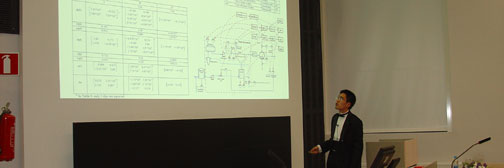| | Year 2008
Olli SorvariDevelopment of methods for calculating pressure relief flows and sizing relief devices
A pressure relief device is used for keeping process equipment pressure below its design pressure when all the other devices connected to the equipment fail to do so. The key factor in this objective is the properly sized relief area of the pressure relief device. If it happens that the orifice area is not sufficient, pressure will build up in the equipment and serious consequences follow, possibly rupture of the equipment. On the other hand, if the orifice area is too large, the relief mass flow might be too large for the outlet piping or for the flare to handle. This may cause serious damage to equipment downstream of the relief device or even a release of toxic and hazardous fluids into the environment.
Pressure relief valve sizing for single-phase flow is straightforward. Widely accepted calculation schemes for this can be found in standards by The American Petroleum Institute (API). In cases when the fluid flowing into a pressure relief valve is a vapour-liquid mixture or a flashing or condensing fluid, a correlation for two-phase flow has to be used. An accurate method for two-phase flow is in great interest, since flashing flow may require much larger relief area than pure liquid flow. The literature part of the thesis overviews different methods for calculating two-phase pressure relief flows and sizing pressure relief devices. In valve sizing, a discharge coefficient is used to account for the difference between the mass flow given by a theoretical model and the mass flux flowing in the actual relief valve. Different models for two-phase discharge coefficient are investigated and evaluated.
In the experimental part of the thesis, calculation routines are programmed, which are then used for comparing various methods especially in situations where the accuracy of the API 2000 method was reported to be low. The calculation schemes of ω HEM, API 2000, ISO/DIS 4126-10 and HDI were chosen for comparison. The HDI method proved to be the most accurate method in the simulations. The drawback of the method is the demanding calculation procedure which includes numerous flash calculations. API 2000 was able to provide results very close to HDI in many cases. Only at low vapour fractions or at condensing gas/supercritical flow service, the differences were more pronounced. A method of HDI NE is suggested, which is based on the use of a non-equilibrium factor. The non-equilibrium factor is a function of vapour mass fraction and nozzle length. The method was originally presented by Darby (2000). This method improves the prediction accuracy of the HDI method at low vapour fractions considerably.
Deprecated: strlen(): Passing null to parameter #1 ($string) of type string is deprecated in C:\WWWroot\Root\incs\5_theses\theses_new2010.php on line 248
This info last modified 27 Apr 2024 by Jerri Kämpe-Hellenius
|

